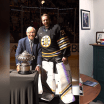Sasakamoose, Indigenous NHL pioneer, dies at 86
Played 11 games with Black Hawks in 1953-54, had been hospitalized with COVID-19
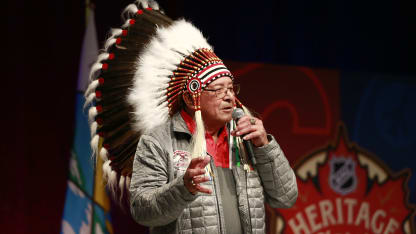
© Jeff Vinnick/Getty Images
Sasakamoose, who had lived on the Ahathkakoop Cree Nation reserve in Saskatchewan, was tested for COVID-19 on Nov. 19 and the test came back positive two days later, according to his son, Neil Sasakamoose.
He received antibiotics intravenously and was placed on oxygen, but his lungs could not recover, his son said.
"This COVID virus just did so much damage into his lungs, he just couldn't keep responding, his body just couldn't keep up," Neil said in a video posted on Facebook. "When I talked to him, I asked him how he was feeling, if he was scared. He said, 'I'm not scared, I'm ready to go, if I gotta go, I'm going to go.' I said, 'You know what, Dad? If you're tired, you go. You go and don't worry about us over here.'"
Sasakamoose did not have a point in 11 games with the Black Hawks in 1953-54.
"Only 125 hockey players and six teams, and I was one of them," he told Global News in 2018.
Family, friends and the hockey world mourned the loss of a man who overcame Canada's abusive residential school system to become the first Indigenous player with treaty status in the NHL.
"Fred Sasakamoose was a Canadian original who attained one of his life goals at the age of 19, by becoming the first Cree player to appear in an NHL game, and then dedicated the rest of his long life to serving the First Nations community -- using hockey and other sports to provide opportunities for Indigenous youth," NHL Commissioner Gary Bettman said. "The story of Sasakamoose's groundbreaking, 11-game NHL career with the Chicago Black Hawks in 1953-54 was the culmination of years of dedication to overcoming adversity in pursuit of a dream, and the pivot point at which he turned his focus to helping others pursue their dreams.
"On a personal note, I will always treasure meeting Fred at the 2019 Heritage Classic in his native Saskatchewan, getting to spend some precious time getting to know him and the gift he gave me that day -- a statue depicting his NHL rookie card. The National Hockey League mourns the passing of this special man and sends its condolences to his family and the countless young men and women of the First Nations community whose lives he touched."
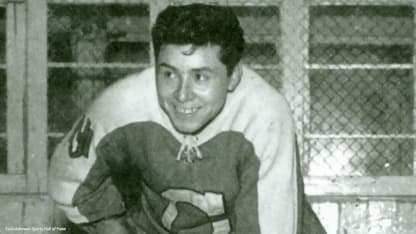
Sasakamoose's NHL career was brief, but he blazed a trail for players and coaches of Indigenous heritage, including Carey Price, Jordin Tootoo, Bryan Trottier, Reggie Leach, George Armstrong, Ted Nolan, Craig Berube, Sheldon Souray, Gino Odjick and Theo Fleury.
Trottier, a Hockey Hall of Fame center who scored 1,425 points (524 goals, 901 assists) for the New York Islanders and Pittsburgh Penguins and won six Stanley Cup championships, called Sasakamoose "a pioneer, somebody looked at with First Nation blood who was an achiever, broke barriers.
"He didn't realize how inspiring he was, which makes him a humble man, which, to me, is much like Jean Beliveau and Gordie Howe and all of those guys who we hold in such high regard."
Leach, who scored 666 points (381 goals, 285 assists) in 934 games with the Boston Bruins, California Golden Seals, Philadelphia Flyers and Detroit Red Wings and was voted the Conn Smythe Trophy winner as the most valuable player in the 1976 Stanley Cup Playoffs, said he didn't know about Sasakamoose until he was 16 and playing junior hockey in Flin Flon, Manitoba.
Leach said that when he learned Sasakamoose was First Nation, he was instilled with pride.
"He was one of the players that we wanted to be like him and play in the National Hockey League," Leach said. "He accomplished his goal and that was a big feat at that time in the 50s, being First Nation and playing in the NHL. If you think back, it's unbelievable the things he had to go through and what he went through going to residential school and accomplishing what he did. It's just amazing."
Sasakamoose made his NHL debut Nov. 20, 1953, against the Boston Bruins and played against the Toronto Maple Leafs two days later. He was then sent back to junior but was informed on the night of his final game with Moose Jaw of the Western Canadian Junior Hockey League that the Black Hawks wanted him to report for a game at the Toronto Maple Leafs on Feb. 27, 1954.
"That night. I was on that train," he told the Edmonton Sun in March 2014. "Going to Toronto. Going to play. Three days on a train. I don't know how the word got out that fast that there was an Indian going to play.
"I was warming up on the ice, and somebody skated up to me and said, 'Somebody wants to talk to you over there.' I'd never seen (broadcaster) Foster Hewitt in my life. He was just on the radio. He said, 'How do you pronounce your name?' … It was big news. It was a big deal. I was an Indian with an Indian on my sweater."
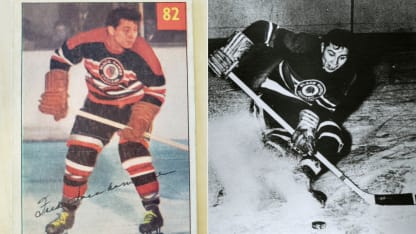
Sasakamoose went to training camp with the Black Hawks in 1954 but was sent to the minors. He played minor and senior hockey until retiring in 1960.
"Today we lost a luminary in the hockey world with the passing of Fred Sasakamoose," the Blackhawks said in a statement. "Fred inspired many across the sport and throughout North America after becoming one of the first Indigenous-born athletes to play in the National Hockey League when he played 11 games with the Blackhawks during the 1953-54 season. Fred's family spoke of his love for his culture, his people and his language. That lasting impact of his legacy will forever be celebrated and continue to bring people together for generations to come.
"To the entire Sasakamoose family that includes his wife, Loretta, four children and over 100 grandchildren and great-grandchildren, the Chicago Blackhawks organization extends our deepest condolences."
After his playing career was over, Sasakamoose returned home to the Ahathkakoop First Nation to help give others the same kind of opportunities he received. He worked to build and develop minor hockey and other sports in the community. Tournaments, leagues and sports days followed as a result of these initiatives, as well as the Saskatchewan Indian Summer and Winter Games. Sasakamoose also was on the NHL Diversity Task Force as well as the Aboriginal Healing Foundation.
Sasakamoose had a long, difficult path to the NHL, which included being taken from his family's home and shipped to the St. Michael's Indian Residential School in Duck Lake, Saskatchewan. The school was part of a government-sponsored, religious education system designed to assimilate the country's Indigenous children. The schools, which began in the 1880s and closed in 1996, were rife with abuse.
But Sasakamoose never abandoned his language, cultural beliefs or way of life. He testified before Canada's Truth and Reconciliation Commission in 2012 about his experiences at the residential school.
He was inducted into the Saskatchewan Sports Hall of Fame in 2007. The Blackhawks honored him in November 2002, and the Edmonton Oilers did the same in 2014 as part of their Celebration of First Nations Hockey, with Sasakamoose performing the ceremonial puck drop before a game against the New York Rangers. In 2017, Sasakamoose was invested in the Order of Canada, an honor that recognizes Canadian citizens for outstanding achievement, dedication to community or service to the nation.
Sasakamoose's death came a week after he finished the final edits on his memoir. "Call Me Indian: From the Trauma of Residential School to Becoming the NHL's First Treaty Indigenous Player" is scheduled for release April 6.
"At least his story is documented and now it's done," Neil said.
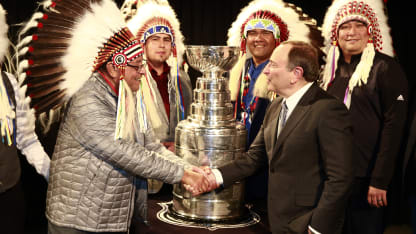
© Jeff Vinnick/Getty Images








